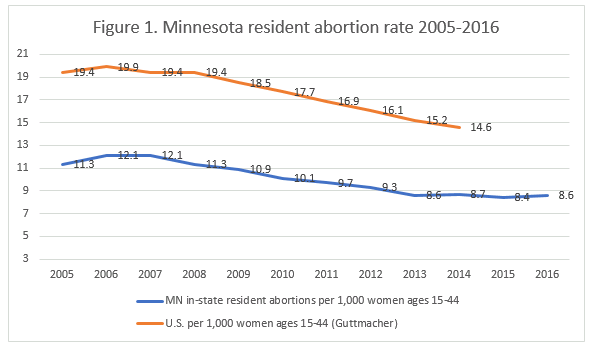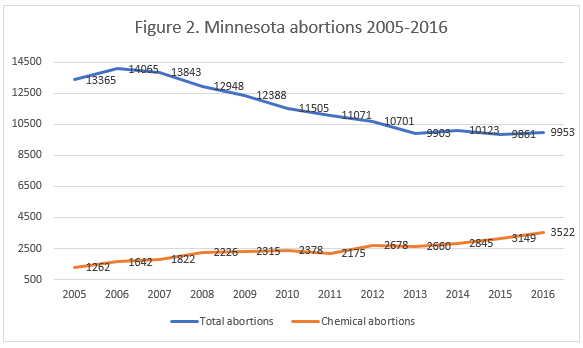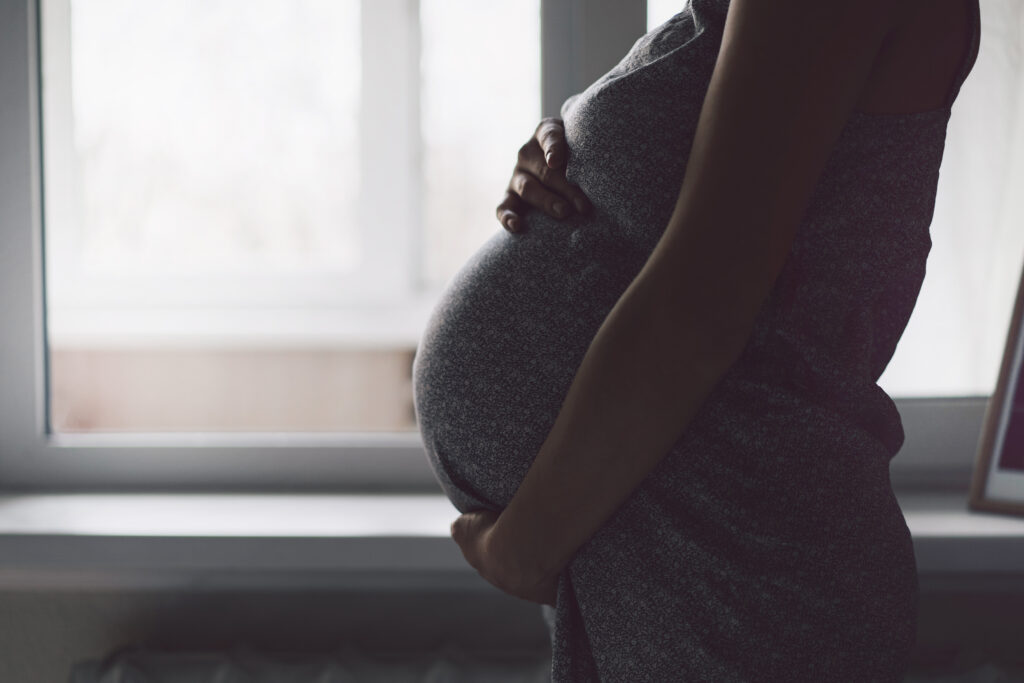Abortion Reporting: Minnesota (2016)
Minnesota’s 2016 abortion report provides a detailed look at abortion trends in the state. Published on-time every July by the Minnesota Department of Health, the 63-page report reveals that the state’s abortion rate increased slightly over the previous year from 8.4 to 8.6 (Fig. 1).
Statistics and Changes in Minnesota Abortions, 2015-2016

Abortion Totals and Trends
Total abortions in Minnesota have been slowly decreasing since 1999, when its current abortion reporting statutes went into effect. While abortions went up by not quite 1 percent from 2015, total abortions performed in the state dropped by 31 percent between 1999 and 2016. At the same time, chemical abortions have been increasing. In 1999, 81 chemical abortion procedures were performed, accounting for slightly more than half of 1 percent of all abortions. By 2016, the number of chemical abortions had increased by almost 4,250 percent to 3,522 abortions, making up a little over 35 percent of Minnesota abortions. Between 2015 and 2016, chemical abortions rose by nearly 12 percent (Fig. 2). The abortion rate increased slightly between 2015 and 2016, rising from 8.4 in 2015 to 8.6 in 2016.
State Report Summary
In 2016, 9,953 abortions occurred in the state of Minnesota, with 91 percent of those being performed on Minnesota residents. Forty-five percent of total Minnesota abortions and 49 percent of abortions on Minnesota residents were publicly funded using state revenue. Minnesota’s public assistance provides coverage through MinnesotaCare, which funds abortions in the case of rape, incest, or risk to the life and health of the mother, and Medical Assistance (the state Medicaid program), which funds a wider scope of abortions, including elective abortions for “therapeutic” reasons. In 2013, the year before Minnesota expanded Medicaid coverage under the Affordable Care Act, 10 percent less of abortions were funded with public assistance (i.e., 35 percent of total abortions and 38 percent of resident abortions). Fifty-seven percent of women getting abortions in 2016 were in their twenties, and only 28 abortions were performed on girls younger than 15. Slightly more than half of women seeking abortions were white. Twenty-four percent were high school graduates, and an additional 29 percent had college credit but no degree. Eighty percent of women were unmarried. Forty-two percent of women had had no previous live births, and 79 percent had never had an abortion. Most abortions performed in Minnesota, 67 percent, occurred at less than nine weeks of gestation, while less than one and a half percent of abortions were performed after 20 weeks of gestation. Minnesota reports information on both intraoperative and postoperative complications; 64 abortions caused complications that were identified during the procedure, and 83 abortions caused complications that were identified later1. The most common reason for abortion, given by 67 percent of women, was that they did not currently want children. Less than 1 percent of abortions were performed because of pregnancy resulting from rape. Sixteen percent of women said they were using contraception at the time they became pregnant. Sixty-nine percent of the doctors performing abortions in Minnesota specialized in obstetrics and gynecology, and ninety-three percent of abortions were performed in clinics.
Well over half of Minnesota abortions were performed by Planned Parenthood, which was responsible for 5,629 abortions in Minnesota in 2016. Planned Parenthood’s market share was more than double that of the next-largest abortion provider, Whole Woman’s Health, which performed 2,365 abortions. Minnesota is one of only five states to provide information on the facilities that perform abortions.
Born Alive Infants Protection Act
Minnesota’s 2016 abortion report contains data from the first full year of reporting after the passage of the Born Alive Infants Protection Act, which mandates that “A born alive infant as a result of an abortion shall be fully recognized as a human person, and accorded immediate protection under the law.” Enacted in 2015, the law made Minnesota one of only four states to include in its abortion reports information on infants born alive. Doctors are required to report whether a baby was born alive during an attempted abortion, the steps taken to save the baby’s life, whether the baby survived, and, if so, what happened to the baby afterward. In 2016, five babies were born during attempted abortions. One baby displayed “transient cardiac contractions,” but no attempts were made to save his or her life. Two more babies had what where classified as “lethal fetal anomalies,” and once again, no steps were taken to keep them alive. Finally, two infants received previously planned “comfort care measures” and passed away soon afterward. Minnesota’s abortion reports for 2015 and 2016 show that since the law went into effect in July 2015, all the children reported to have been born alive during abortions died shortly after birth.
Conclusion
A study on state abortion reporting published by the Charlotte Lozier Institute determined that out of the 50 states, New York City, and the District of Columbia, Minnesota ranked second best for comprehensive abortion reporting. The Lozier Institute identified Minnesota as a leading model for other states to emulate because of the quality, speed, and efficiency of its reporting. The state reports data elements that few other states include, such as contraception use, method of payment for the abortion, and facility where the abortion occurred, yet spends only $4,000 to compile, print, and mail its annual reports. By implementing Minnesota’s system, other states could improve the quality of their reporting and lower their costs.

Note: According to Minnesota’s 2016 abortion report, the 2016 rate was calculated using 2015 population estimates.

- Statistics on abortion complications reported here represent a minimal number of deaths and complications, as this data is collected in a non-systematic and non-verifiable way. As such, this data cannot be used to calculate either an accurate abortion mortality rate, nor an accurate abortion complication rate for the state.
Click here to view reporting from:2023202220212020201920182017


























